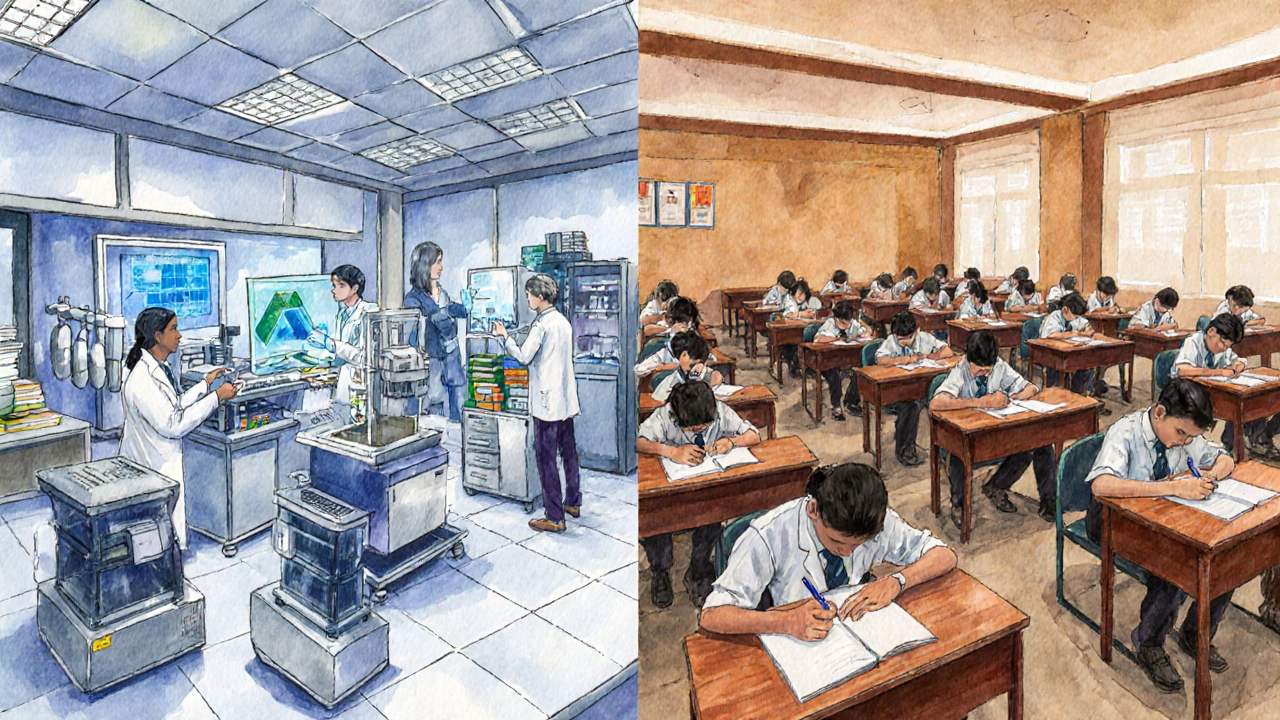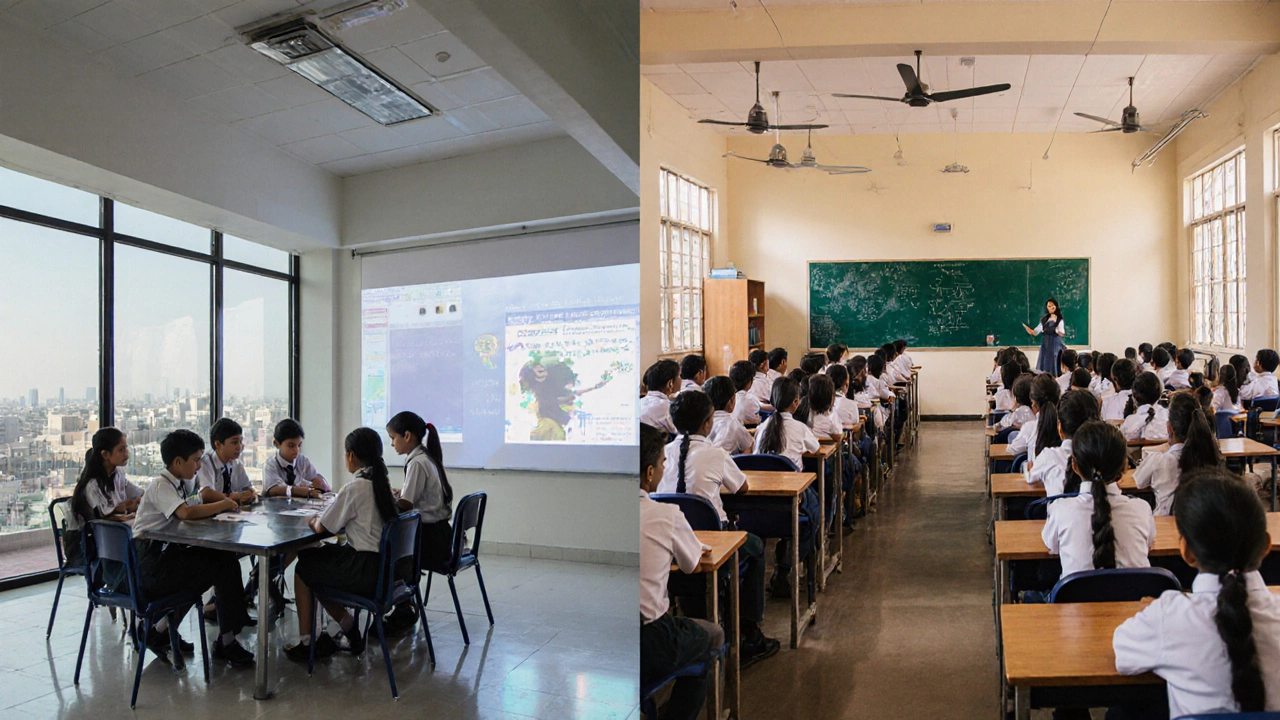Education Cost Comparison Calculator
Your Child's Education Details
Key Cost Facts
• Dubai private schools average $15,000/year
• India private schools average $2,000/year
• Dubai public schools average $12,000/year
• India public schools average $300/year
Pro Tip: Dubai schools often provide better facilities and lower student-teacher ratios, but costs are significantly higher. India's system offers more affordable education with strong STEM preparation.
Cost Comparison Results
Total Cost (Dubai)
$0
Total Cost (India)
$0
When parents, students, or expats ask, “Is Dubai education better than India?,” they’re really looking for a side‑by‑side view of two very different schooling ecosystems. Both have strong points, but they serve distinct priorities-whether it’s global university pathways, cost considerations, or cultural fit. Below you’ll find a straightforward breakdown that lets you weigh the facts and decide which system lines up with your goals.
Key Takeaways
- Dubai schools blend UAE national standards with international curricula (IB, British, American), offering high global mobility.
- India’s system is massive, exam‑focused, and excels at producing strong STEM graduates.
- Cost per student in Dubai is 3‑5 times higher than in India, but facilities and teacher‑student ratios are generally better.
- Both systems are recognised worldwide, but Dubai’s international programs often ease university admission abroad.
- Choosing the right system depends on your priorities: global mobility, cost, academic rigor, or cultural alignment.
What Makes Dubai Education Unique?
Dubai education is a hybrid model that combines the UAE Ministry of Education’s national curriculum with a suite of international programmes such as the International Baccalaureate (IB), British GCSE/A‑Levels, and US Advanced Placement (AP). The city hosts roughly 200 private schools and 40 public schools, serving a highly multicultural student body-over 80 nationalities on average.
Key attributes:
- Curriculum diversity: Over 60% of schools offer at least one international track.
- Facilities: State‑of‑the‑art labs, sports complexes, and smart‑classrooms are standard in most private institutions.
- Teacher‑student ratio: Private schools average 1:15, public schools 1:20.
- Language of instruction: Primarily English, with Arabic required for UAE subjects.
- Assessment: Mix of continuous assessment, external exams (IB, GCSE), and national benchmarks.
How India’s Education System Is Structured
Indian education is a vast, centralized network overseen by both central and state boards. The three dominant curricula are the Central Board of Secondary Education (CBSE), the Indian Certificate of Secondary Education (ICSE), and various State Boards. A significant portion of schools follow a traditional, exam‑centric approach that emphasizes mathematics, science, and rote learning.
Key attributes:
- Scale: Over 1.5 million schools, serving more than 250 million students.
- Curriculum focus: Strong emphasis on STEM subjects and competitive exam preparation (NEET, IIT JEE).
- Language of instruction: English in many private schools; regional languages dominate state‑board schools.
- Teacher‑student ratio: Public schools average 1:30 to 1:40, private schools 1:20 to 1:25.
- Assessment: High‑stakes board exams at Grades 10 and 12, supplemented by internal assessments.

Side‑by‑Side Comparison
| Aspect | Dubai | India |
|---|---|---|
| Curriculum Types | National + IB/GCSE/AP (60% of schools) | CBSE/ICSE/State Boards (mostly national) |
| Average Tuition (per year) | USD 12,000 - 30,000 | USD 300 - 4,000 (private); negligible for public |
| Teacher‑Student Ratio | 1:15 (private), 1:20 (public) | 1:30‑40 (public), 1:20‑25 (private) |
| International Recognition | High - IB, A‑Levels widely accepted | High - CBSE/ICSE accepted globally; additional entrance exams often needed |
| Language of Instruction | English (primary), Arabic (mandatory UAE subjects) | English (private), regional languages (state) |
| Facilities | Modern labs, sports complexes, smart boards | Varies widely; top private schools comparable, many public schools limited |
| Focus Areas | Holistic development, global citizenship | STEM excellence, competitive exam prep |
Pros & Cons of Dubai’s System
Pros
- Broad choice of curricula lets families target specific university destinations.
- World‑class facilities and low teacher‑student ratios enhance learning experiences.
- English‑dominant environment eases transition to Western higher‑education institutions.
- Strong emphasis on extracurriculars nurtures well‑rounded profiles for college applications.
Cons
- Tuition is steep; not affordable for most middle‑class families.
- High turnover of expat teachers can affect continuity.
- National curriculum requirements add extra workload for students.
Pros & Cons of India’s System
Pros
- Massive scale makes education accessible to a wide socio‑economic spectrum.
- Strong focus on mathematics and science consistently produces top performers in global STEM competitions.
- Board exam results are standardized and widely recognized across Indian universities.
- Private schools offering IB or Cambridge curricula provide international pathways at a lower cost than Dubai.
Cons
- Rote‑learning emphasis can limit critical thinking and creativity.
- Public school infrastructure often lags behind demand.
- English proficiency varies, sometimes hindering smooth transition to English‑medium universities abroad.
- High‑stakes board exams create intense pressure on students.

Which System Is Better for Specific Goals?
- Goal: Study abroad in the UK, US, or Canada? Dubai’s IB or A‑Level tracks typically align directly with admission criteria, reducing the need for additional conversion exams.
- Goal: Secure a spot in top Indian engineering or medical colleges? Indian board exams (CBSE) paired with dedicated coaching give the most direct route.
- Goal: Minimize education costs while still gaining an international credential? Look for Indian private schools that offer Cambridge International or IB at a fraction of Dubai’s fees.
- Goal: Holistic development (sports, arts, leadership)? Dubai schools often embed extracurricular programs into the daily schedule, whereas Indian schools may need separate coaching centres.
- Goal: Relocate frequently as an expat? Dubai’s internationally accredited curricula ease transitions across UAE, GCC, and Western schools.
Practical Tips for Making the Right Choice
- Identify your long‑term academic destination. If you aim for a Western university, prioritize IB or A‑Level pathways.
- Calculate total cost of education. Include tuition, transport, uniforms, and extra‑curricular fees.
- Visit schools (virtual tours work too). Observe class sizes, teacher interaction, and facility quality.
- Check accreditation. Ensure the school’s programme is recognized by the universities you’re targeting.
- Consider cultural fit. Dubai offers a multicultural atmosphere; Indian schools can provide a stronger connection to native languages and traditions.
Frequently Asked Questions
Is the Dubai education system recognized by universities in the US?
Yes. Most Dubai schools follow IB, AP, or British A‑Levels, all of which are accepted by US universities. Students usually need to submit SAT or ACT scores, but the curriculum itself meets admission standards.
How do Indian board exam results compare internationally?
CBSE and ICSE scores are widely understood, but many foreign universities require additional qualification tests (e.g., SAT, IELTS) to gauge English proficiency and analytical skills.
Can a student switch from an Indian curriculum to Dubai’s IB midway?
Switching is possible but challenging. IB’s first year (PYP/MYP) assumes a certain skill set. Parents should ensure the student has strong English, research skills, and a willingness to adapt to inquiry‑based learning.
What are the average class sizes in Dubai private schools?
Typical private school classes range from 12 to 20 students, allowing more personalized attention compared to Indian public schools.
Is it cheaper to send a child to an Indian school in Dubai than to a local UAE school?
Yes. Indian curriculum schools in Dubai often charge 30‑40% less than schools offering full UAE or Western curricula, making them a popular choice for the Indian expatriate community.
Both Dubai and India offer solid educational pathways; the “better” choice hinges on your family’s priorities, budget, and long‑term academic plans. Use the comparison above as a checklist, and you’ll land on the system that best supports the student’s aspirations.

